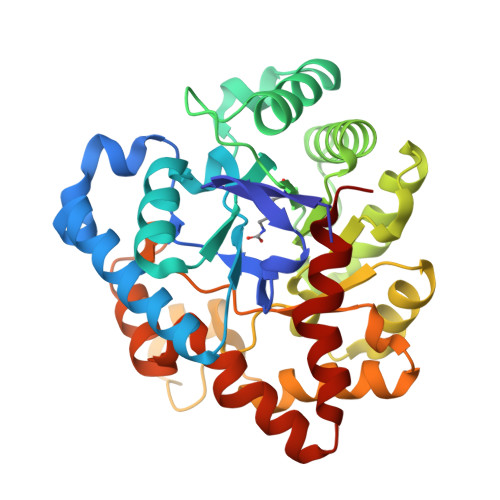A 5000-fold increase in the specificity of a bacterial phosphotriesterase for malathion through combinatorial active site mutagenesis
Naqvi, T., Warden, A.C., French, N., Sugrue, E., Carr, P.D., Jackson, C.J., Scott, C.(2014) PLoS One 9: e94177-e94177
- PubMed: 24721933
- DOI: https://doi.org/10.1371/journal.pone.0094177
- Primary Citation of Related Structures:
3WML, 4NP7 - PubMed Abstract:
Phosphotriesterases (PTEs) have been isolated from a range of bacterial species, including Agrobcaterium radiobacter (PTEAr), and are efficient enzymes with broad substrate ranges. The turnover rate of PTEAr for the common organophosphorous insecticide malathion is lower than expected based on its physical properties; principally the pka of its leaving group. In this study, we rationalise the turnover rate of PTEAr for malathion using computational docking of the substrate into a high resolution crystal structure of the enzyme, suggesting that malathion is too large for the PTEAr binding pocket. Protein engineering through combinatorial active site saturation testing (CASTing) was then used to increase the rate of malathion turnover. Variants from a CASTing library in which Ser308 and Tyr309 were mutated yielded variants with increased activity towards malathion. The most active PTEAr variant carried Ser308Leu and Tyr309Ala substitutions, which resulted in a ca. 5000-fold increase in kcat/KM for malathion. X-ray crystal structures for the PTEAr Ser308Leu\Tyr309Ala variant demonstrate that the access to the binding pocket was enhanced by the replacement of the bulky Tyr309 residue with the smaller alanine residue.
Organizational Affiliation:
Department of Environmental Sciences, COMSATS Institute of Information Technology, Abbottabad, Pakistan; Ecosystem Sciences, Commonwealth Scientific and Industrial Research Organisation, Canberra, Australian Capital Territory, Australia.



















